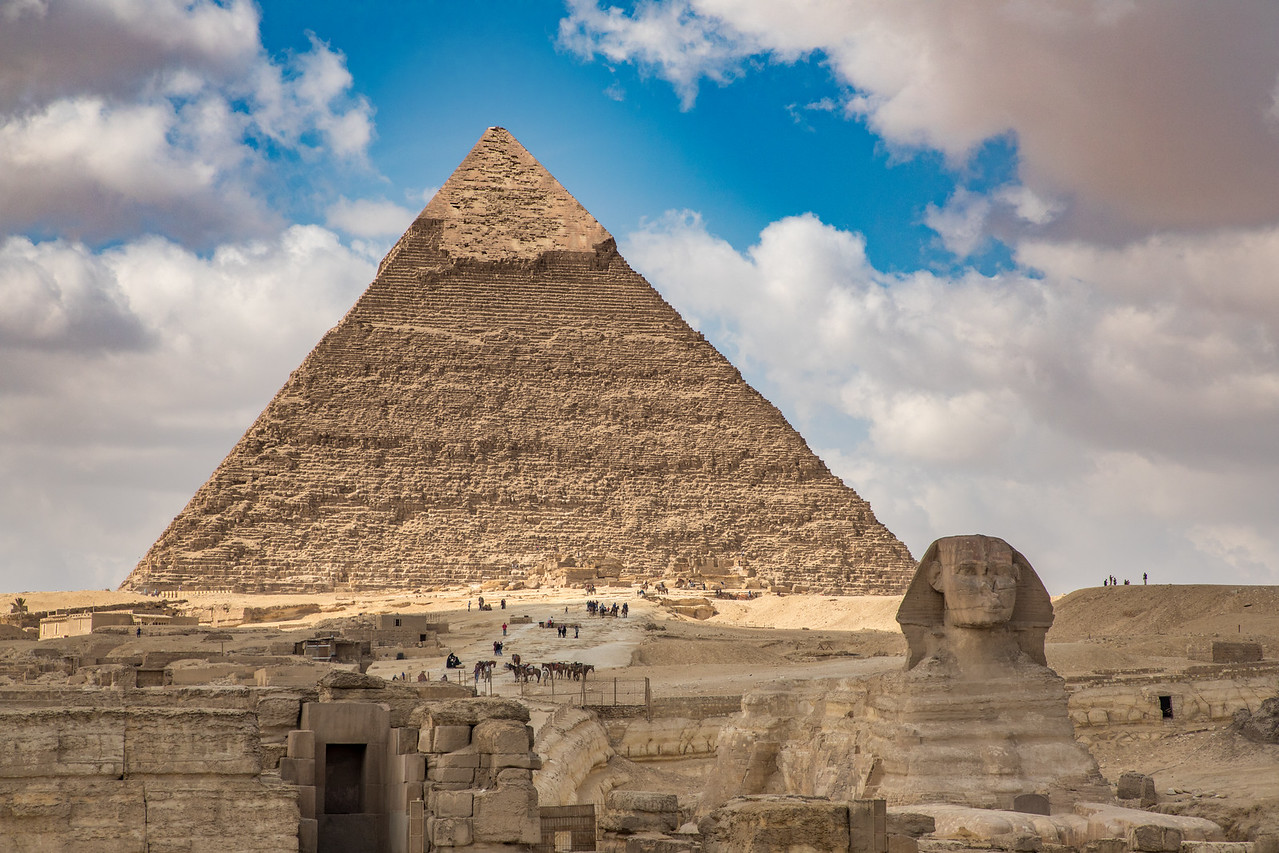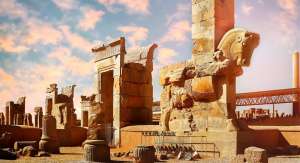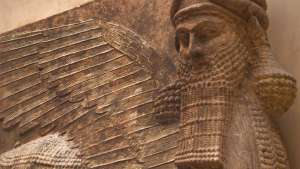The pyramids of Egypt fascinated travellers and conquerors in ancient times and continue to inspire wonder in the tourists, mathematicians, and archeologists who visit, explore, measure, and describe them.
Tombs of early Egyptian kings were bench-shaped mounds called mastabas. Around 2780 B.C., King Djoser's architect, Imhotep, built the first pyramid by placing six mastabas, each smaller than the one beneath, in a stack to form a pyramid rising in steps. This Step Pyramid stands on the west bank of the Nile River at Sakkara near Memphis. Like later pyramids, it contains various rooms and passages, including the burial chamber of the king.
The transition from the Step Pyramid to a true, smooth-sided pyramid took placed during the reign of King Snefru, founder of the Fourth Dynasty (2680-2560 B.C.). At Medum, a step pyramid was built, then filled in with stone, and covered with a limestone casing. Nearby at Bahshur, construction was begun on a pyramid apparently planned to have smooth sides. About halfway up, however, the angle of incline decreases from over 51 degrees to about 43 degrees, and the sides rise less steeply, causing it to be known as the Bent Pyramid. The change in angle was probably made during construction to give the building more stability. Another great pyramid was built at Dahshur with its sides rising at an angle of somewhat over 43 degrees, resulting in a true, but squat looking pyramid.

The largest and most famous of all the pyramids, the Great Pyramid at Giza, was built by Snefru's son, Khufu, known also as Cheops, the later Greek form of his name. The pyramid's base covered over 13 acres and its sides rose at an angle of 51 degrees 52 minutes and were over 755 feet long. It originally stood over 481 feet high; today it is 450 feet high. Scientists estimate that its stone blocks average over two tons apiece, with the largest weighing as much as fifteen tons each. Two other major pyramids were built at Giza, for Khufu's son, King Khafre (Chephren), and a successor of Khafre, Menkaure (Mycerinus). Also located at Giza is the famous Sphinx, a massive statue of a lion with a human head, carved during the time of Khafre.
Pyramids did not stand alone but were part of a group of buildings which included temples, chapels, other tombs, and massive walls. Remnants of funerary boats have also been excavated; the best preserved is at Giza. On the walls of Fifth and Sixth Dynasty pyramids are inscriptions known as the Pyramid Texts, an important source of information about Egyptian religion. The scarcity of ancient records, however, makes it difficult to be sure of the uses of all the buildings in the pyramid complex or the exact burial procedures. It is thought that the king's body was brought by boat up the Nile to the pyramid site and probably mummified in the Valley Temple before being placed in the pyramid for burial.

Who Built the Egyptian Pyramids?
Although it’s certainly more plausible than hypotheses like ancient aliens or lizard people, the idea that slaves built the Egyptian pyramids is no more true. It derives from creative readings of Old Testament stories and technicolor Cecil B. Demille spectacles, and was a classic whataboutism used by slavery apologists. The notion has “plagued Egyptian scholars for centuries,” writes Eric Betz at Discover. But, he adds emphatically, “Slaves did not build the pyramids.” Who did?
The evidence suggests they were built by a force of skilled laborers, as the Veritasium video above explains. These were cadres of elite construction workers who were well-fed and housed during their stint. “Many Egyptologists,” including archeologist Mark Lehner, who has excavated a city of workers in Giza, “subscribe to the hypotheses that the pyramids were… built by a rotating labor force in a modular, team-based kind of organization,” Jonathan Shaw writes at Harvard Magazine. Graffiti discovered at the site identifies team names like “Friends of Khufu” and “Drunkards of Menkaure.”
Laborers were also working off an obligation, something every Egyptian owed to those above them and, ultimately, to their pharoah. But it was not a monetary debt. Lehner describes what ancient Egyptians called bak, a kind of feudal duty. While there were slaves in Egypt, the builders of the pyramids were maybe more like the Amish, he says, performing the same kind of obligatory communal labor as a barn raising. In that context, when we look at the Great Pyramid, “you have to say ‘This is a hell of a barn!’’’
The evidence unearthed by Lehner, Hawass, and others has “dealt a serious blow to the Hollywood version of a pyramid building,” writes Shaw, “with Charlton Heston as Moses intoning, ‘Pharaoh, let my people go!’” Recent archeology has also dealt a blow to extra-terrestrial or time-travel explanations, which begin with the assumption that ancient Egyptians could not have possessed the know-how and skill to build such structures over 4,000 years ago. Not so. Veritasium explains the incredible feats of moving the outer stones without wheels and transporting the granite core of the pyramids 620 miles from its quarry to Giza.
Ancient Egyptians could plot directions on the compass, though they had no compasses. They could make right angles and levels and thus had the technology required to design the pyramids. What about digging up the Great Pyramid’s 2 million blocks of yellow limestone? As we know, this was done by a skilled workforce, who quarried an “olympic swimming-pool’s worth of stone every eight days” for 23 years to build the Great Pyramid, notes Joe Hanson in the PBS It’s Okay to Be Smart video above. They did so using the only metal available to them, copper.
This may sound incredible, but modern experiments have shown that this amount of stone could be quarried and moved, using the technology available, by a team of 1,200 to 1,500 workers, around the same number of people archaeologists believe to have been on-site during construction. The limestone was quarried directly at the site (in fact the Sphinx was mostly dug out of the earth, rather than built atop it). How was the stone moved? Egyptologists from the University of Liverpool think they may have found the answer, a ramp with stairs and a series of holes which may have been used as a pulley system.
















